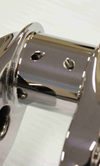Superfinishing
 There are often lots of shiny parts in a race engine, and some companies produce parts of a high surface finish as a sales point; there is a perception by some that a polished part is better quality and therefore has an inherently higher value.
There are often lots of shiny parts in a race engine, and some companies produce parts of a high surface finish as a sales point; there is a perception by some that a polished part is better quality and therefore has an inherently higher value.
There are very good reasons though why some parts benefit from having a high level of surface finish. One only has to look at the data presented in engineering textbooks on the subject of fatigue strength and cyclic loading to realise that improving surface finish has a direct and beneficial impact on fatigue life. In the same way that grinding offers an improvement in fatigue strength over conventional machining processes such as milling and turning, polishing offers an improvement on a ground finish.
The polishing process is often described as 'superfinishing', with polishing often considered to be a manual and uncontrolled process, where superfinishing is an automatic process with controllable parameters.
There are other reasons why a very smooth surface finish might be desirable on some engine components, particularly those in lubricated sliding contact. Superfinishing is commonly called for on camshafts to improve wear resistance and to improve the frictional behaviour of the cam-to-follower contact. Owing to the relative motion of the camshaft and follower, an oil film is formed, and the thickness of this film is affected by a number of parameters such as pressure, sliding velocity and certain qualities of the lubricant.
One thing we need to appreciate though is that any surface, however smooth it appears to be visually, has peaks and troughs - high points and low points - and it is the high points of surfaces that are most likely to come into contact with each other and which might therefore cause wear damage. Where the 'combined' height of the peaks on each surface is of a greater thickness than the oil film, metal-to-metal contact ensues, and the lubrication regime is said to be 'mixed', with the friction coefficient being higher than a contact in a fully hydrodynamic or elasto-hydrodynamic regime.

Reducing the height of the peaks, by improving the surface finish through superfinishing, allows us to decrease both the coefficient of friction and the probability of damage being caused to one or both of the components in the contact. Both friction and wear are equally unwelcome in a race engine. If we imagine a cam follower wearing, the surface finish is roughened, and we can understand that this becomes a self-sustaining cycle with accelerated wear and ever-increasing friction.
An automated polishing process is often achieved by placing the parts in a machine containing media in constant motion. This might be anything from a vibratory finishing machine using crushed walnut shell as a polishing media to others where carefully shaped ceramics and polymer media are used, and where the motion of the media might be more carefully controlled. Such ceramic and polymer media might be conical, cylindrical or tetrahedral in form and may be used with an abrasive paste or liquid depending on the application. Examples of race engine parts that are commonly superfinished are crankshafts, camshafts, cam followers, valves, valve springs and gears, although this is by no means an exhaustive list.
Fig. 1 - Crankshafts are one of a number of race engine components that are commonly superfinished (Courtesy of Winberg Crankshafts)
Written by Wayne Ward